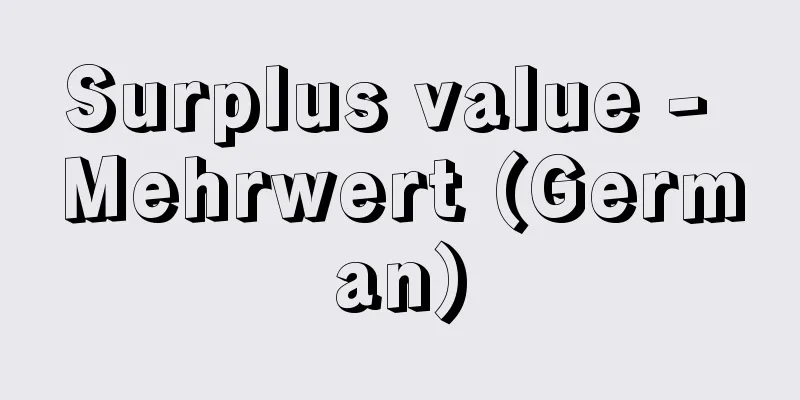Surplus value - Mehrwert (German)

|
Capital is a self-increasing value, and the part of value that grows relative to the capital value invested is called surplus value. The ratio of this surplus value to the total capital invested is the profit rate, and when surplus value is considered to be the product of the total capital invested, it is called profit. Profit is the transformed form of this surplus value. And the industrial profits obtained by industrial capitalists, the commercial profits obtained by commercial capitalists, the interest obtained by loan capitalists, and the rent obtained by landlords all have this surplus value as their source and are nothing but its division. The defining objective of capitalist production is the production of surplus value, but surplus value is not produced in the circulation process in which goods are bought and sold. Surplus value is produced in the production process by the labor of workers employed by industrial capitalists. The movement of industrial capital is By the way, how is a commodity containing surplus value produced? Let us assume that a worker produces 50 pounds of thread by working 8 hours a day, that the value of the means of production required for this is 10,000 yen, that the daily value of labor power is 4,000 yen, and that an average hour of labor produces a value of 1,000 yen. In this case, the value of the consumed means of production is transferred to the value of the product, the thread, without changing the magnitude of the value during the production process. In contrast, in the case of labor power, new value is added when it is consumed. Since an average hour of labor produces a value of 1,000 yen and it is assumed that a worker works for 8 hours, the new value added to the product is 8,000 yen, and the value of 50 pounds of thread is 18,000 yen in total. By selling it at value, the capitalist recovers the invested capital of 14,000 yen and at the same time realizes a surplus value of 4,000 yen, which is the value portion that exceeds the capital investment. As is clear from this, the basis for the generation of surplus value is the labor power commodity. The labor-power commodity has its own use value, which is the creation of value through its consumption, and creates value greater than its own value. In this example, the daily value of labor-power is 4,000 yen, so a worker only needs to work 4 hours to reproduce it, but this does not prevent the worker from working more than that, and surplus value is produced by this surplus labor. In this way, a worker's daily working hours = working day is made up of two parts. One is the time required to reproduce the value of labor power, which is called necessary labor time, and the labor expended during this time is called necessary labor. The other is the time that a worker works beyond the necessary labor time, which is called surplus labor time, and the labor expended during this time is called surplus labor, and this is how surplus value is produced. In this case, Capitalists strive to increase the rate of surplus value, but there are two ways to do so. The necessary labor time for reproducing the value of labor power during the working day is constant under given production conditions. In this case, the longer the working day is, the longer the surplus labor time becomes, and the higher the rate of surplus value becomes. This is called the production of absolute surplus value. However, there are physiological and social limits to the unlimited extension of the working day, and the working class also opposes it. As a result of the struggle between labor and capital over the working day, a standard working day is set by law. If the unlimited extension of the working day becomes impossible, in order to increase the rate of surplus value, it is necessary to shorten the necessary labor time and thereby expand the surplus labor time. This is called the production of relative surplus value. To do this, the value of labor power must be reduced. Since the value of labor power is determined by the value of the means of life consumed by the working family, the productive forces of society must be increased in order to produce relative surplus value. The production of relative surplus value is carried out through competition between capitalists over special surplus value (the difference between social value and individual value). [Nihei Satoshi] "Kapital by K. Marx, Vol. 1, Parts 2-5 (translated by Itsuro Mukaizaka, Iwanami Bunko / translated by Jiro Okazaki, Otsuki Shoten, Kokumin Bunko)" ▽ "Wage Labor and Capital by K. Marx, translated by Fumio Hasebe (Iwanami Bunko)" [Reference] | | |Source: Shogakukan Encyclopedia Nipponica About Encyclopedia Nipponica Information | Legend |
|
資本とは自己増殖する価値であり、投下された資本価値に対して増殖する価値部分を剰余価値という。この剰余価値の投下総資本に対する比率が利潤率であり、剰余価値が投下総資本の産物と意識されるとき、剰余価値は利潤とよばれる。利潤はこの剰余価値の転化された現象形態である。そして産業資本家の得る産業利潤、商業資本家の得る商業利潤、貸付資本家の得る利子、地主の得る地代は、この剰余価値を源泉とし、それが分割されたものにほかならない。 資本制的生産の規定的目的は剰余価値の生産であるが、商品の売買が行われる流通過程では、剰余価値は生産されない。剰余価値は、産業資本家によって雇われた労働者の労働によって生産過程で生産されるのである。産業資本の運動は、 ところで、剰余価値を含んだ商品はどのようにして生産されるのであろうか。いま労働者が1日8時間労働することによって50ポンドの糸を生産するものとし、これに要する生産手段の価値が1万円、労働力の日価値が4000円、そして平均的1時間労働が1000円の価値を生むものと仮定しよう。この場合、消費された生産手段の価値は、生産過程で価値の大きさを変えることなく生産物である糸の価値に移転されていく。これに対して労働力の場合には、これが消費されることによって新しい価値を付加する。平均的1時間労働が1000円の価値を生み、労働者は8時間労働すると仮定されているから、生産物に新たに付加される価値は8000円となり、糸50ポンドの価値は合計1万8000円となる。資本家はこれを価値どおりに販売することによって、投下資本1万4000円を回収すると同時に、それを上回る価値部分4000円の剰余価値を実現する。これから明らかなように、剰余価値の発生根拠は労働力商品にある。労働力商品は、それを消費することが価値の創造であり、しかもそれ自身の価値よりも大きな価値を創造するという独自な使用価値をもっている。この例では労働力の日価値は4000円であるから、それを再生産するためには労働者は4時間労働すればよいが、このことはそれを上回って労働することを妨げるものではなく、この剰余労働によって剰余価値が生産されるのである。 このように労働者の1日の労働時間=労働日は二つの部分からなっている。一つは労働力の価値を再生産するのに必要な時間であり、これを必要労働時間、この間に支出される労働を必要労働という。いま一つは労働者が必要労働時間を上回って労働する時間であり、これを剰余労働時間、この間に支出される労働を剰余労働といい、これによって剰余価値が生産される。この場合、 資本家は剰余価値率を増大させようと努力しているが、剰余価値率を増大させるには、次の2通りの方法が存在する。すなわち、労働日のうち労働力の価値を再生産する必要労働時間は、所与の生産諸条件のもとでは一定であるから、この場合、労働日を延長すればするほど剰余労働時間は長くなり、剰余価値率は増大する。これを絶対的剰余価値の生産という。しかし、労働日の無制限的延長には生理的限界および社会的限界があり、労働者階級も反対する。労働日をめぐる労資の闘争の結果、法律によって標準労働日が設定されるようになる。こうして労働日の無制限的延長が不可能となったならば、剰余価値率を増大させるためには、必要労働時間を短縮し、それによって剰余労働時間を拡大する必要がある。これを相対的剰余価値の生産という。そのためには労働力の価値を引き下げなければならない。労働力の価値は労働者家族が消費する生活手段の価値によって決まるので、相対的剰余価値の生産のためには社会の生産力を上昇させなければならない。相対的剰余価値の生産は、特別剰余価値(社会的価値と個別的価値との差額)をめぐる資本家相互の競争を媒介として行われる。 [二瓶 敏] 『K・マルクス著『資本論』第1巻第2~5篇(向坂逸郎訳・岩波文庫/岡崎次郎訳・大月書店・国民文庫)』▽『K・マルクス著、長谷部文雄訳『賃労働と資本』(岩波文庫)』 [参照項目] | | |出典 小学館 日本大百科全書(ニッポニカ)日本大百科全書(ニッポニカ)について 情報 | 凡例 |
<<: Surplus - joyokin (English spelling) surplus
Recommend
Dibbets, BJC (English spelling) DibbetsBJC
…During the Dutch War of Independence (1632), the...
Bonds - Insurance
Securities issued by the state, local governments...
Kishimoto Suifu
Senryu (Japanese senryu) writer. His real name wa...
Lilium medeoloides (English spelling) Lilium medeoloides
…[Tetsuichi Yahara]. … *Some of the terminology t...
Toyooka [Village] - Toyooka
A village in Iwata County, western Shizuoka Prefec...
Africaan
…Nevertheless, whites occupy nearly 90% of the la...
Persian lilac (English spelling)
…It is also often planted as a garden tree or roa...
Goebbels - Joseph Goebbels
A politician of Nazi Germany. Born into a middle-...
Grisaille
...Camaille also refers to the process of paintin...
inverted echo sounder
...A sonic wave gauge is installed on the ocean f...
Acanthopeltis japonica Okamura
A red alga (illustration) with a cylindrical body,...
Diopter
… [Adjustment] The point at which you can see cle...
Chinese liquor - Chugokushu
Alcohol made in China or using Chinese methods. W...
Georgia [State] - Georgia
A state in the southern United States. Abbreviated...
Helotrephidae
…There are about 20 species of Asellota in Japan....









